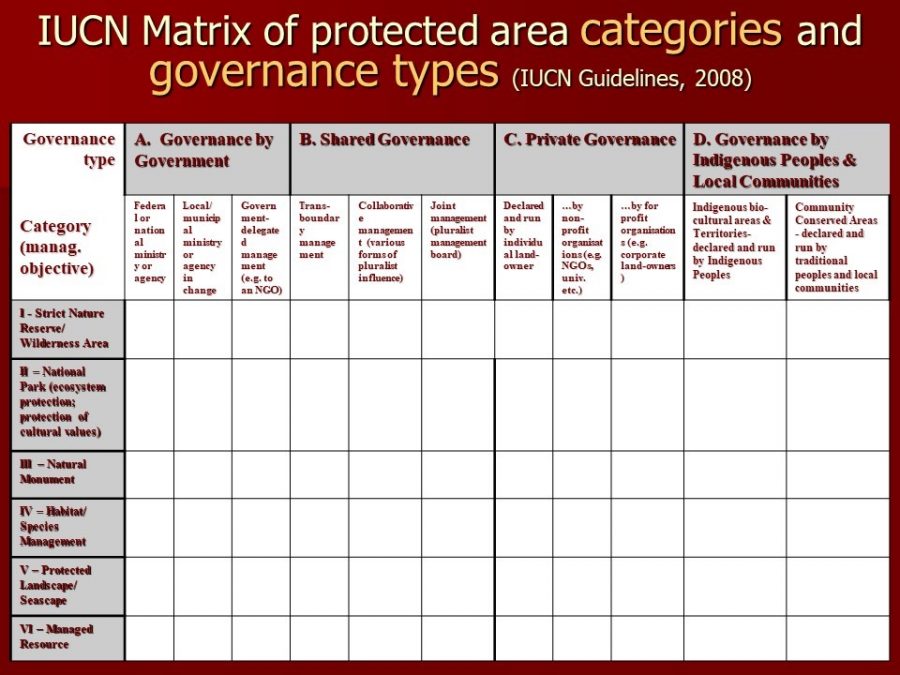
Protected areas
Protected areas have been identified by the Convention on Biological Diversity (CBD) as one of the fundamental instruments for the promotion of in-situ conservation, acting as positive drivers of biodiversity protection, preservation of environmental services, and climate change mitigation. For the CBD a protected area is a “geographically defined area which is designated or regulated and managed to achieve specific conservation objectives.” The IUCN has a broadly equivalent, although richer, definition. For IUCN a protected area is “a clearly defined geographical space, recognised, dedicated and managed, through legal or other effective means, to achieve the long-term conservation of nature with associated ecosystem services and cultural values”.[1]
The IUCN also stresses that, in order to qualify as ‘protected’, an area must be managed with conservation of nature as a conscious management objective, which “must prevail in case of conflict with other, equally legitimate, objectives”.[2] Protected areas currently encompass 14.9% of world land (over 20 million Km2) and 7.3% of marine areas (over 6 million Km2),[3] under diverse management categories and governance types. The IUCN has identified six management categories, each characterised by a main management objective (e.g., to protect the long-term ecological integrity of an area; to protect a representative ecosystem or a valuable natural feature; to maintain or restore a species, habitat, landscape, or the sustainable use of some natural resources; etc.). The IUCN also distinguishes four main governance types for protected areas, depending on who holds main authority, responsibility and accountability for the key decisions (government agencies; private or corporate landowners; indigenous peoples and local communities; or several of them together) (see #Governance).[4]
Regardless of management category, protected areas may belong to any governance type. Conversely, regardless of governance type, they can be managed to fit any management category. The many possible combinations of management category and governance type (see Figure 2 below) add flexibility to the protected area instrument for different aims and circumstances.[5]

Territories and areas governed, managed and conserved by their custodian indigenous peoples and local communities – in fewer words ‘ICCAs—territories of life’ – are today one of the four main governance types officially recognised for protected areas by both the IUCN and the CBD.[6] Given that they were nowhere to be found in the mental landscape of conservationists up to the end of the past millennium, this recognition is very important. But the requirement of the paramount conservation objective is an obstacle for some custodians. They may be conserving their territories, but the objective may be their own livelihoods or spiritual fulfilment or anything else they chose. In this sense they may have ‘conserved territories or areas’ but do not fit in the protected area label under the IUCN definition. This very fact is in good part responsible for the coming to prominence of the term ‘#conserved areas’ in conservation circles.
CBD Aichi Target 11 requires protected areas to be equitably managed (a fact that should be better expressed as ‘equitably governed’).[7] CBD decisions at various COPs have explained that this entails recognition and respect for the rights of indigenous peoples and local communities as well as their positive involvement in governance and management. This is expected to ensure that their knowledge, capacities and institutions do contribute to conservation, while they also receive fair benefits from it. In line with this, the CBD Programme of Work on Protected Area recommended enhancing diversity of governance in protected area systems, thus recognising and supporting ICCAs. And CBD COP 14 has recently approved a Voluntary guidance on effective governance models for management of protected areas, including equity.[8] While steps forward have been made, a policy-to-practice lag remains and emerging international principles struggle to be translated in domestic legal systems. The historical ‘command and control’ approach to protected areas is still too often reflected in current processes of establishment and implementation. Most protected areas have been set-up by imposition, excluding pre-existing rightsholders and custodians. Today, even in the countries that have tried to overcome past negative approaches, one can still perceive a nature-culture dualism[9] at odds with the values and conservation practices of many indigenous peoples.[10]
Importantly, even though they are widespread and encompass very diverse areas, protected areas are under serious pressure,[11] and certainly do not encompass all areas valuable for the conservation of nature (see #Conserved areas).
Protected areas overlapping with ICCAs: negotiating borders and governance types
Frequently, protected areas have been established over pre-existing ICCAs—territories of life.[12] In such cases of ‘overlaps’, the local customary governance and management practices that achieved conservation through time are at risk of being undermined or impaired, and particularly so when there is little recognition of the value of the role of their custodian indigenous peoples or local communities. These problematic practices can be improved through dialogue and negotiated agreements and arrangements between governments and ICCA custodians, often as a result of affirmation of indigenous peoples’ and local communities’ collective rights and responsibilities and possible revisions of national laws and administrative rules and regulations.[13]
Overlapped ICCAs can be recognised through diverse means. An ICCA can be recognised as a protected area governed by its custodians, with their free, prior and informed consent and, where needed, by providing assistance to local governance institutions, as in the case of the Indigenous Protected Areas of Australia. A shared governance arrangement could be developed for the entire protected area with provisions ensuring respect for the overlapped ICCAs, as in the case of Yapoporis National Park of Colombia. The custodians may be recognised an official governance role in a given section of the protected area. Or the protected area borders may be modified to exclude the ICCA territory.
IUCN has adopted multiple policies calling for recognition and support for ICCAs,[14] which include ICCAs within protected areas as stressed by IUCN Resolutions,[15] the World Conservation Congress of 2016[16] and CBD Decisions.[17] Guidelines are now in development by IUCN and the ICCA Consortium to provide best practice guidance for recognising and respecting overlapped ICCAs in protected areas of all governance types and management categories.[18]
Can protected areas work in isolation?
Aichi Biodiversity Target 11 of the Strategic Plan for Biodiversity 2010-2020 calls the Parties to the Convention to achieve the following: “By 2020, at least 17% of terrestrial and inland water areas and 10% of coastal and marine areas, especially areas of particular importance for biodiversity and ecosystem services, are conserved through effectively and equitably managed, ecologically representative and well-connected systems of protected areas and other effective area-based conservation measures, and integrated into the wider landscape and seascape”.[19] The CBD thus calls for the promotion of systems of protected areas and other effective area-based conservation measures – recognising that isolated areas are unable to fulfil meaningful conservation objectives. One can also interpret ‘systems’ as referring to a desirable multiplicity of management categories and governance types in the landscape/seascape.
Key references:
IUCN, 2003; Dudley, 2008; Borrini-Feyerabend et al., 2013; IUCN, 2014; Stevens et al., 2016; Stevens, Pathak Broome and Jaeger, 2016; World Conservation Congress, 2016; Convention on Biological Diversity 2018a; Convention on Biological Diversity, 2018b; Garnett et al., 2018; UNEP-WCMC, IUCN and NGS, 2018. Mulrennan, Scott and Scott, 2019.
See also: Protected planet
[1] Dudley, 2008, page 8.
[2] Borrini-Feyerabend and Hill, 2015, page 177.
[3] UNEP-WCMC, IUCN and NGS, 2018, page 6.
[4] Borrini-Feyerabend et al., 2013.
[5] Borrini-Feyerabend and Hill, 2015, Box 7.5.
[6] Convention on Biological Diversity, 2004a; Convention on Biological Diversity, 2018a; Convention on Biological Diversity 2018b; Dudley, 2008; IUCN, 2003; IUCN, 2014.
[7] The 20 Aichi Biodiversity Targets are to be reached by 2020, in order to achieve the 5 strategic goals of the CBD. See: https://www.cbd.int/sp/targets/
[8] Convention on Biological Diversity, 2018b.
[9] ‘Nature-culture dualism’ is the understanding that human culture is separate from, and superior to, nature. This believe is foundational for Western modernism and enabled colonialism, i.e., the dominance over the ‘natural world’ as well as peoples considered ‘close to nature’. See Blaser, 2013.
[10] Lee, 2016.
[11] Jones et al., 2018.
[12] Stevens et al. 2016. ICCAs can be overlapped not only by protected areas but also by concessions granted by the State to extractive industries, even within protected areas. All ICCAs are vulnerable to overlap of extractive industrial concessions and State promotion of large-scale infrastructure projects. Some indigenous peoples and local communities have sought protected area status for their territories and lands in the hope of preventing these external impacts on their ICCAs. But in many countries even protected areas are not necessarily safe from these threats (Stevens et al., 2016 and Stevens, Pathak Broome and Jaeger, 2016).
[13] See, for example, Mulrennan, Scott and Scott, 2019.
[14] IUCN, 2004.
[15] IUCN, 2012.
[16] IUCN, 2014.
[17] Convention on Biological Diversity, 2016.
[18] Steven et al., forthcoming. Two ICCA Consortium publications already provide some guidance: the ICCA Consortium Policy Brief no. 4, which summarises concerns and discussions related to ICCAs overlaps with protected areas, and an in-depth report that includes greater attention to relevant international law and policy (Stevens et al. 2016; Stevens, Pathak Broome and Jaeger, 2016).
[19] Convention on Biological Diversity, 2010; see also Convention on Biological Diversity 2011c.